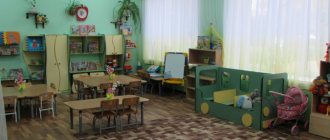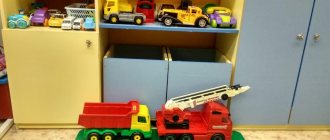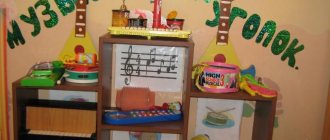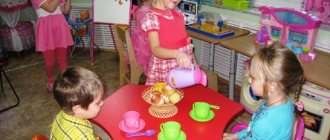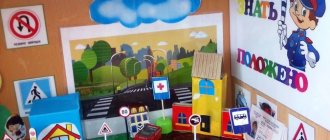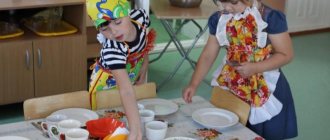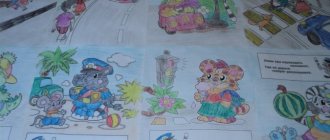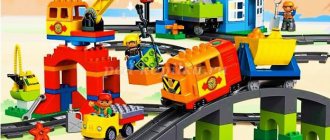Which centers in the group should be used for speech development?
Speech is one of the important mental functions. It allows you to transfer information. The child must acquire speech skills in preschool age. They are not given at birth, and speech has to be taught. This applies to all children without exception. Few people perceive speech by ear and independently. In most cases, it takes a lot of effort to teach speaking skills on time. This is a concern for both preschool teachers and parents.
A developing subject-spatial environment is an organized space with selected materials and equipment. It helps teach a child a variety of age-appropriate skills. Here it is written in detail about the requirements for a development environment.
A subject-spatial environment conducive to speech is formed in the premises of the preschool educational institution group. It consists of several centers (corners, or stands). For children of different ages, the list of stands may be almost the same, but their content will differ. The following centers will help you work with speech:
- speech and book;
- game;
- theatrical;
- art center;
- sensory-constructive;
- others (indirectly).
There are certain requirements for the developing subject-spatial environment in kindergarten. According to the Federal State Educational Standard, it should be easily transformable, rich in content, multifunctional, accessible, safe, aesthetically attractive, and psychologically comfortable. And quickly transform into a conventional space for the current game: a clinic, a cafe, a clearing in the forest.
An organized subject-speech environment should help resolve the following issues:
- develop vocabulary;
- work on grammatical structure (teach word formation and correct grammatical structures);
- develop coherent speech (learn to retell, describe, guess riddles);
- to form a full-fledged sound culture of speech (improve breathing, improve auditory attention and clarity of sound pronunciation);
- develop fine motor functions.
The group environment should be age appropriate. And allow the alternation of different activities: educational, social and independent. A rich and appropriate developmental environment will be exciting for the child. It will improve speech and diversify the development of the baby.
Slide captions:
Equipping a speech corner in accordance with the Federal State Educational Standard in the second junior group. Nikiforova A.O. Group No. 13
1.Formation of vocabulary 1. Based on enriching ideas about the immediate environment, continue to expand and activate children’s vocabulary. 2. Clarify the names and purposes of items of clothing, shoes, hats, dishes, furniture, and types of transport. 3. Develop the ability to distinguish and name essential details and parts of objects (for a dress - sleeves, collar, pockets, buttons), qualities (color and its shades, shape, size), surface features (smooth, fluffy, rough), some materials and their properties (paper easily tears and gets wet, glass objects break, rubber toys restore their original shape after being compressed), location (outside the window, high, far away, under the cabinet). 4. Draw children’s attention to some objects that are similar in purpose (plate - saucer, chair - stool, fur coat - coat - sheepskin coat). 5. Develop the ability to understand general words (clothing, dishes, furniture, vegetables, fruits, birds, etc.); name the parts of the day (morning, afternoon, evening, night); name domestic animals and their babies, vegetables and fruits. Objectives of speech development in accordance with the requirements of the modern Federal State Educational Standard:
2. Formation of sound culture of speech 1. Improve children’s ability to clearly pronounce vowels in words (a, u, i, o, e) and some consonant sounds (p - b - t - d - k - g; f - v; t - s - z - c). 2. Develop motor skills of the speech-motor apparatus, auditory perception, speech hearing and speech breathing, clarify and consolidate the articulation of sounds. 3. Develop the correct tempo of speech and intonation expressiveness. 4. Develop the ability to clearly pronounce words and short phrases, speak calmly, with natural intonations.
3. Formation of the grammatical structure of speech 1. Improve children’s ability to coordinate adjectives with nouns in gender, number, case; use nouns with prepositions (in, on, under, for, about). 2. Help to use in speech nouns in singular and plural form, denoting animals and their young (duck - duckling - ducklings); the plural form of nouns in the genitive case (ribbons, nesting dolls, books, pears, plums). Treat children's word creation as a stage of active mastery of grammar, prompt them to the correct form of the word. 3. Help children obtain common ones from common simple sentences (consisting only of a subject and predicate) by introducing definitions, additions, and circumstances into them; make sentences with homogeneous members (“We will go to the zoo and see an elephant, a zebra and tigers”).
4. Formation of coherent speech 1. Develop a dialogical form of speech. Involve children in conversation while looking at objects, paintings, illustrations; observations of living objects; after watching performances and cartoons. Develop the ability to conduct a dialogue with the teacher: listen and understand the question asked, answer it clearly, speak at a normal pace, without interrupting the adult speaking. Remind children of the need to say “thank you”, “hello”, “goodbye”, “good night” (in the family, group). 2. Develop children’s proactive speech in interactions with adults and other children. In order to develop initiative speech, enrich and clarify ideas about objects in the immediate environment, provide children with pictures, books, and sets of objects for independent examination.
It is advisable to place the speech corner next to the book corner. The design of the corner should be aesthetic. Game material must be accessible to the child. Do not overload the corner with equipment. An integral attribute of the speech corner should be a toy - an “animate character”. When organizing a speech corner, the following requirements must be observed:
We use material from the corner of knowledge: D didactic games to develop the ability to distinguish and name essential details and parts of objects (for a dress - sleeves, collar, pockets, buttons), qualities (color and its shades, shape, size), surface features (smooth, fluffy, rough), some materials and their properties (paper easily tears and gets wet, glass objects break, rubber toys restore their original shape after being compressed), location (outside the window, high, far away, under the closet). freshwater”, etc. 1. Formation of a dictionary
2.Sound culture of speech
Grammatical structure of speech Connected speech
Thank you for your attention!
The speech center is one of the main ones for the development of speech
Most often, the speech development corner is combined with the book corner. The tasks for both are similar. They form a vocabulary, learn to listen, describe objects and phenomena.
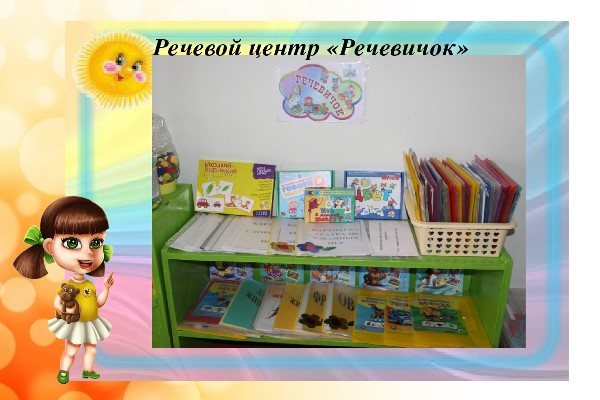
The content of the thematic rack of these two centers can be as follows:
- Books – fiction and educational.
- Didactic games for speech development.
- Sets of plot, subject and thematic pictures.
- Various games and lotto.
A literary center for the little ones can contain only 4-5 books on cardboard or a thick base. Volume – up to 5 pages. We need to prepare a few more replacement books. Editions with moving eyes, windows, etc. would be very appropriate. A good option would be transformable books, folding ones, panoramas with moving figures, etc. Publications with animal voices will also come in handy.
Now - in more detail about filling the speech center for the first junior group. Try using these elements:
- Sets of thematic pictures or postcards (4-6 pieces each) on the theme of domestic and wild animals, birds, fish, trees, flowers, fruits and vegetables, food, transport, furniture, dishes, clothing.
- Pictures for grouping according to a specific criterion.
- Pictures (3-4 pieces each) to create a sequence (plot of a fairy tale, story).
- Pictures 4 pcs. for times of day and seasons.
- Large, colorful pictures on social everyday life or fairy tale themes - something that will be interesting to the child.
- Lotto with images of birds and pets.
- Various games and aids that form correct breathing (“Butterflies”, “Leaves”, tubes, light snowflakes made of paper, etc., where you need to use a stream of air).
- Aids and toys for the development of phonemic awareness (rattles, noise instruments, music boxes).
- Aids for articulation exercises, including wall and individual mirrors.
The speech development center must have sufficient space. So that children alternately study while sitting on the carpet, at tables, or move according to the rules of the games. Equipment for story-based didactic games can be stored not only on stands. But also in baskets or boxes. It is worth putting the appropriate pictures on them so that the children themselves can get what they need.
Where should you start?
The use of a developmental environment is directly related to its organization. The task of the preschool educational institution staff is to take care of the main centers (or corners) in the kindergarten group, focused on the development of a particular skill. Several subject centers will help you improve, develop, and polish your speech. More on them a little later.
For a methodologist who will draw up methodological recommendations, it is important to understand two things: what to write and how to write. How to write, that is, the structure of recommendations, can be seen in other similar documents. I have selected a small list of references that you can refer to. And additionally extract useful information from these manuals. So, publications on the topic:
- A manual on planning and monitoring the subject-spatial environment for senior educators.
- A publication with notes and presentations on creating a developmental environment according to the Federal State Educational Standard. Includes both book and CD.
- Another guide to creating a developmental environment. This time only the disk .
- The subject-spatial environment must not only be created and developed. We need to monitor her condition. An assessment and control journal in the form of a paper book and a program for installation on a PC .
- A couple of useful offline webinars. The first is to build a developmental environment in an early age group. And here is another version of the same webinar. The second is more specialized and concerns specifically the speech environment in preschool educational institutions.
- And another webinar . He will tell you how to systematize the environment in accordance with the age of kindergarteners.
- Advanced training course on designing a subject-spatial developmental environment in preschool educational institutions . There is an option to start in August. And there is the same one that starts in September .
- Professional retraining course . Concerns issues of subject-spatial and inclusive environment.
